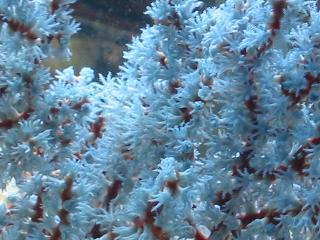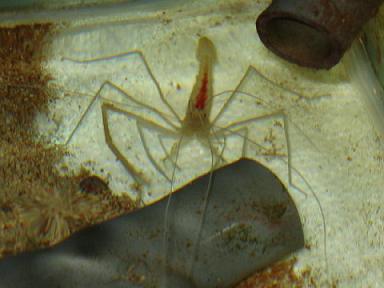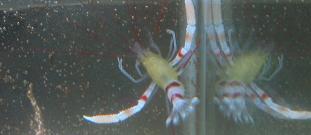-
Posts
10,123 -
Joined
-
Last visited
-
Days Won
17
Content Type
Profiles
Forums
Gallery
Everything posted by FuEl
-
Came across these 2 sites with regards to goniopora care. Hopefully they are of help. Think it was mentioned that dosing iron and manganese seem to encourage polyp extension.
-
Somehow the pic makes me feel hungry. Nice clam!
-
If I don't remember wrongly croceas are actually rock boring clams, meaning they will attach themselves to a piece of rock and slowly burrow into it by dissolving the rock with a secretion. Croceas are also one of the most light demanding species compared to maximas and derasas. It will be more happy if it is closer to the light source. The best bet would be around the placement of your leather coral or if possible higher up. 150 W metal halides don't really exhibit the best light penetration compared to 250 W. Furthermore 14,000K bulbs have the lowest light intensity compared to 6,500K or even 10,000K bulbs. If you had 250 W halides at 14,000K I'm sure you might ble able place it at the bottom but since it is 150 W 14,000K it's best to be on the safe side of things by placing it as high as possible. Small clams require more phytoplankton compared to larger clams slimpy because they are at a critical stage of development. They have a great amount of growing to do and thus require the frequent feedings of phytoplankton to grow rapidly. It's best if you can afford to feed them daily by inverting a glass bottle over the clam and introducing phytoplankton into the bottle via a small syringe. That way the phytoplankton is utilized better and does not go all over the place (Eg. to your skimmer). And both calcium and kH levels are very important to clams for shell growth. It is recommended to keep an eye on these 2 parameters, especially kH. Try to keep Ca levels around 400-450 ppm and kH around 8-10. Hope I did'nt sound too wordy, after all clams are CITES II organisms and should be given the best care possible.
-
Update.. http://www.ibnlive.com/article.php?id=7015§ion_id=2
-
http://www.wildsingapore.com/news/20060102/060223-1.htm Come to think of it, so easy to purchase a shark.
-
Yep. Sea fans don't really taste good. Don't ask how I know.
-
Not so bad yet..just some wind and rain. Will tell you guys if I can see possums flying.
-
http://www.bom.gov.au/products/IDQ65002.shtml After anticipating to experience one after about 1 yr spent in Aussie it has finally come! Think I'm nuts to be excited about a category 4 and possibly category 5 cyclone. Hope some unique reptiles will fall from the sky into my hands.
-
It's getting there jervismun! Just remember to feed daily. Small frequent feedings over the day is better than a big feeding once a day.
-
Garlic juice and even human grade garlic oil both work. Only reason might be the pellets. Imagine the amount of garlic solution pellets can absorb. Doubt fish will take food which tastes more like garlic than fish food.
-
Too much coralline is a headache once they take up all the calcium and carbonates in your water. Imagine your calcium media in the calcium reactor being used up mainly by coralline.
-
Go barebottom and siphon the bottom for wastes everyday. Won't need skimmer already.
-
-
Thanks iantoh, just thought I should share my experiences since I managed to propagate these guys. The rotifers I used in the past were marketed by LiquidLife USA and they were dead concentrates. As a result my water probably turned into a nutrient soup. Live rotifers should work better and would surely preserve your water quality better. I think what iantoh meant by laminar flow is current moving primarily in one direction, but not in the form of a jet like those produced by powerheads. It's more like high volume, low velocity flow like those produced by Seios or Tunzes. These guys don't require light and the presence/absence of light does'nt really bother them. Just don't place them in well-lit areas if you have algae problems, especially diatoms. Such algae will slowly smother seafans if they are allowed to take hold.
-
Yes that is a very old photo, back when I was fragging these guys. Small pieces are actually easier to care for compared to large ones. Simply because these guys grow according to their natural conditions in the wild. So most of the time large specimens fail because their flow conditions cannot be met. If you notice one side of the seafan is concave, it's a good bet that you should have that side facing the current.
-
-
And I thought my friend's Lancer was weird.
-
-
-
-
dk008>>Not really in outback, more of bushland. Daytime can chase frilled dragons. At night I talk to possums and white's treefrogs. Another pic to share, a pistol shrimp I have so far failed to identify.
-
Food will not be an issue to them. They will eat any scraps that your fish miss out. If they are another species besides Calcinus elegans I doubt they are reef safe and might pose a danger to small fish. If they are Calcinus elegans then you have nothing to worry about as this species prefers eating algae to eating meat. If you run out of algae for them you could always feed them nori which can be purchased from ntuc (unseasoned). Also do have extra shells around to let them change shells as they moult and grow.
-
Daytime got mei mei see meh?
-

What to feed Cleaner Shrimp hatchlings?
FuEl replied to arcanehacker's topic in General Reefkeeping_
Newly hatched brine shrimp. -
He cultured hermit crabs before. Talk about the near impossible!







